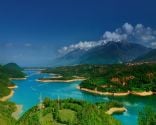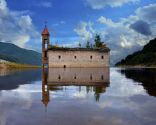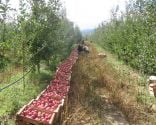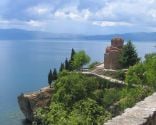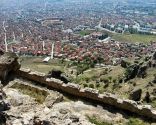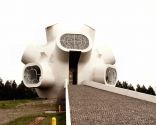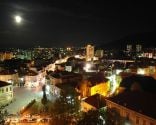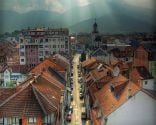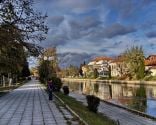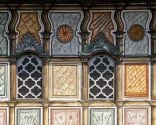Western Macedonia
Western Macedonia has many tourist destinations and attractions including the ones which are most visited. Starting from North to South one can visit a couple of ski centres, a national park with amazing hiking trails and scenery, a small idyllic mountain town with a great cultural significance, two of the largest natural lakes in the Balkans, a city with an even greater cultural significance and a "city of consuls".
Take a look at our list with the cities and destinations as well as the more popular attractions and sights in this region (in alphabetical order).
Bitola (City)
Bitola is the second largest city in the country and has always been an important administrative, cultural, commercial and educational centre. During the ottoman period the city was home to many consulates from European countries and therefore got its nickname "the city of consuls".
Bitola's most famous landmark is the Shirok Sokak, a pedestrian street in the city centre that is the beating heart of the cultural and entertainment events. You can't say you've visited Bitola until you take a stroll down Shirok Sokak and experience the nightlife and daily buzz that it has to offer. The street is filled with countless coffee shops and bars and is packed day in day out, making Bitola one of the best destinations for a vibrant nightlife.
In the vicinity of Bitola is also the ancient town and archaeological dig of Heraclea which is believed to date from the time of Phillip II of Macedon. Same as ancient Ohrid, Heraclea was on the famous Roman Via Egnatia path and today the remains are carefully preserved. A must see are the amazing mosaics still preserved in the basilicas.
Besides the two main landmarks in Bitola, make sure to leave time to see the numerous mosques, squares and if you are lucky to be visiting in the period of the Manaki Brothers Film Festival, make sure you don't miss it.
Read more about Bitola here.
Debar (City and Lake)
Debar is a mountainous town that lies on the banks on a manmade lake that bears the same name. It is famous for Spa & Health Tourism and the natural hot springs. Its Spa Resorts are a top destination for rehabilitation and improving overall health.
Gostivar (City)
Gostivar is the trading centre of the western part of Macedonia and a stopping point for all transit guests heading to the two winter resorts Mavrovo or Popova Shapka or to the summer destinations of Ohrid and Struga. The city is lively with many possibilities for shopping and exploring the surroundings. Gostivar is a trully multi-ethnic city that offers the visitors a unique experience of geting to know three distinct but interlinked cultures.
Kichevo (City)
Kichevo is a town in the heart of the Western region of Macedonia. Situated at more than 600 metres above sea level its surroundings offer many opportunities for nature exploring. Krushino which is a famous area for recreation and hiking can be a great place to visit for nature lovers and thrill seakers both for mountain biking and hiking.
Krushevo (City)
At 1,350m above sea level Krushevo is the highest settlement classified as a city in the Balkans. An integral part of the Baba Mountain this small city that today counts only 9,684 citizens, has a special part in Macedonian culture and history, and at one point in history it was its own Republic.
For the Macedonians, Krushevo is a synonym to the centuries long struggle against Ottoman rule, culminating with the Ilinden Uprising when the freed area was declared a Republic which unfortunately only lasted 10 days, from 2nd of August to the 12th of August, 1903. The rebellion was lead by Macedonian greats Nikola Karev and Pitu Guli. Today the statue Mechkin Kamen stands tall to commemorate the last moments of the uprising when the revolutionaries were killed and Krushevo was burned by an 18,000 strong Ottoman army. Another monument highly identifiable with Krushevo is "Makedonium" which is a massive structure overlooking the city built to commemorate the same uprising.
There are large manifestations on the 2nd of August every year as this day is associated with other milestones in Macedonian history such as the first assembly of the Anti-Fascist Assembly for the People's Liberation of Macedonia (ASNOM), the battle of Ironea in 338 BC and the victory of Phillip II of Macedon against the Peloponnesian city state and the Christian holy day St. Elijah (Sveti Ilinden). Each year there is a traditional Ilinden horseman march from the capital Skopje to Krushevo.
Krushevo is also well known for the astonishing old Macedonian architecture throughout the city and the numerous monasteries and churches surrounding it.
Krushevo must be on your places to visit list when you come to Macedonia.
Read more about Krushevo here.
Mavrovo National Park and Zare Lazarevski Ski Centre
This duo make the area around the largest mountain top in Macedonia, Mt. Korab (2,764m), the most visited mountain resort in the country.
The national park Mavrovo was formed in 1949 to protect the natural beauty, uniqueness and historical significance of the area. Nowadays the national park covers an area of 72,204ha and offers the visitors many opportunities to explore and discover its heritage.
As part of the national park is also the ski centre Zare Lazarevski which is simply known as Mavrovo. It is the most visited ski centre in the country laying on an altitude of 1,200-1,860m above sea level. However being surrounded by high peaks it has enough snow cover for a quality skiing experience throughout the winter. The resorts longest ski trails under the ski lifts are 5km and vary in difficulty, from beginners to professionals.
Ohrid (City & Lake)
Ohrid is a relatively small city of around 60.000 people however during the summer this number can well exceed a 100.000 over any month so if you are arriving with a car expect difficulties finding a parking space in the city centre. Visitors here will experience a wonderful climate during the summer as the city and lake are situated 700 meters above sea level. This means that the average temperature in August is around 28 degrees Celsius (whilst in the warmest city, Gevgelija it stands at 34°C) which combined with the fresh and cool water of the lake provide the perfect getaway from the scorching heat.
Ohrid is by many considered to be the Balkan Jerusalem, and rightly so as the city is one of the oldest with profoundly rich culture and huge significance for the development of the Macedonian nation and religion. The epithets for Ohrid do not stop at a Balkan Jerusalem and similar terms that are based on its cultural heritage but also terms like the Balkan Pearl which try to capture its astounding beauty. Situated on the coast of the ancient lake that bears the same name it is the only area protected and enlisted as a UNESCO World Heritage Site in Macedonia. Although statistically it is the second city visited by tourists in Macedonia, behind Skopje the Capital, its role and significance for Macedonian tourism is unrivalled.
Read more about Ohrid here.
Popova Shapka (Ski Centre)
Popova Sapka is one of the main ski centres in Macedonia and it's altitude is between 1,700 - 2,500 metres above sea level. Located above the city of Tetovo in the north-western part of Macedonia it takes in enough snow for skiing up to early April and is quite popular for off-piste skiing as well. The resort organizes the Sharplaninski Cup each year which is an international skiing event with a long tradition. The ski resort has six ski-lifts and three chair lifts that can suit the requirements from beginners to expert skiers. The village of Popova Shapka is on the hill opposite of the ski area and consists of several hotels, numerous restaurants and mostly private mountain homes.
Getting to the ski centre is best done with a car and it's located 18 km from Tetovo and only 48 km from the capital Skopje.
Prilep (City)
Prilep is one of the major cities of the country and it's situated in the Pelagonia region which is the largest plateau in Macedonia and the main agriculturally cultivated land. There are several things the city of Prilep is known for.
Tobacco has been a long time tradition for Prilep inhabitants. The city is well known for the production of high quality tobacco leafs which are used in established brands worldwide.
King Marko of Prilep is a highly regarded figure in Macedonian history. Being unable to do anything against the expansion of the Ottoman Empire the best way to protect the people a young King Marko became an Ottoman vassal. Macedonian folklore is very rich in glorifying the King. Stories go that he was the strongest man alive, his weapon of choice was huge club weighing 300 oka (400 kilograms), he also had an all mighty horse that could jump from a mountain top to a mountain top. Needless to say he defeated all enemies that threatened the peacefullness and way of life in his kingdom.
Therefore Prilep is known as the city of Marko, and Marko is the protector of the city. The remains of the old fortress can still be seen on the hill overlooking the city. Although hiking there would require some efforts its highly recommended now that you've heard the story about the famous King, plus the views are amazing.
Treskavec Monastery is an old monastery that outdates even the great king. Located at the same hill as King Marko's fortress it is one of the most inaccessible monasteries, reachable only by 4x4 vehicle or by hiking. Its church is dedicated to St. Mary and has astonishing interiors. When you visit the fortress of King Marko don't miss out on this old monastery, which with its beauty is frequently used in Macedonian cinematography.
Resen (City)
Resen is the only city at the vicinity of the second largest lake in Macedonia, Lake Prespa. The city with wonderful climate, high altitude (800m above sea level) and quality soil is most known for the agricultural exploits, with the most famous product the Resen Apple. The most famous landmark in this city is the Saraj (which in Turkish means palace), which is a neoclassical residence built in the 20th century. Nowadays it's used as a House of Culture, gallery and a library supporting the arts, literature, theater and musical activities of the region.
Struga (City)
Struga is the second city destination on the shores of Lake Ohrid and although it's not as visited as the city of Ohrid it is still an important destination. Struga comes to life in the summer with many tourists heading to its hotels and beaches, enjoy the vibrant nightlife and long walks along the shore. At the centre of the city you will find that the city is separated by the outflow of the river Crni Drim from the lake creating a wonderful sight and a popular tourist spot.
However Struga is most famous by one cultural event that has taken place for over 40 years. Since 1966 Struga has been the home of the Struga Poetry Evenings that traditionally take place during the summer. The main award is the Golden Wreath which is handed out to international poets for their achievements in poetry. Winner's lists include world famous Pablo Neruda, Joseph Brodsky, Seamus Heany and many others.
Tetovo (City)
A city located on the foot of the Shar Mountain which represents a true multicultural centre and one of the most economically thriving cities in Macedonia. Although infamous for its traffic jams, one can still find several remarkable attractions of which the Sharena Djamija (translates to Multicoloured Mosque) stands out the most.
Sharena Djamija, built in 1438 on the river Pena is the main landmark in the city and is one of the most beautiful mosques in the country. Across the river there is also a hammam which was a part of the then building expansion of the town. The Leshok Monastery is around 8 km away from the city and is also deserving of a visit. It was built in 1326 and is another example of Byzantine influence in church construction in the country. There are several churches in the complex of which the oldest Church of St. Mary which was joined in the Ohrid Archbishopric in 1019.


